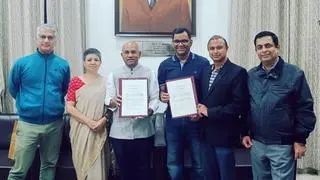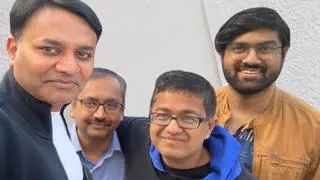After walking through an exhibition one of my friends asked me, “For a change, can’t art come out of its shell and dwell amidst commoners? Become accessible rather than obscure?”
His disappointment in the visual arts is understandable given art’s exclusivity in the modern day.
Although there are more educated people than ever before, there are not many who visit museums or galleries. There is a disconnect between the common man and art today. But was it always like this?
I doubt it, as there are tribal communities to whom art still remains a communal activity. This participatory visual culture is a highlight of their tradition, and helps them retain a sense of unity. But most significantly, it is a question of social attitude and cultural priority that determines the role and place of art in a given society. They might be less educated, but they demonstrate a greater desire to cultivate visual sensibilities.
This precisely is the quality which has disappeared from our educated societies. Therefore it goes without saying that it is actually a mutual abandoning where art and human beings have distanced themselves from one another.
It is possible to enjoy the fruits of science, especially in its technological avatar, without personal engagement or knowledge, but you cannot relish the fruits of arts without personal engagement.
Further, while science is universal, art is personal. Although we are unaware of our intimacy with art, the realm of art begins close to everyday life and stretches to the distant horizon of the higher arts. Even though ostensibly neglected, art in its rudimentary forms finds its way through banal beauties and trivial experiences.
Regardless of shape and size art is everywhere. It touches our skin by caressing us as tattoos, as ornaments, and as outfits we wear. It dwells amidst the decorative embellishments on trucks and taxis that ply on our roads. It is there on painted walls and posters, and in the various banners and signboards we pass by. It lingers in the houses we live, in the furniture we use and in the architectures that seize our attention. Scattered across familiar city corners and parks, we find art manifested in the public statues of great personalities.
Protest, politics or activism also finds voice by wielding art to convey message or spread a word of interest. Religion too is refurbished by art. While permanent places of worship such as traditional temples are embellished by what we call high arts, pandals are put up for seasonal festivals and pujas. We may not always notice them or consider them as art, but they form colourful structures on our streets, house unique goddesses who have the potential to eventually claim a spot in a museum or to be displayed in a gallery.
A pandal made in the mould of Taj Mahal has the ability to transform a busy Kolkata street into the symbol of eternal love. This magical transformation that brings Agra to Kolkata owes itself to the underlying visual culture.
If we keep our eyes and minds open, take note and engage with the little things of beauty and expression around us, we may learn to engage with the high arts that baffle us.
Thus while art might initially appear to be a soliloquy, with gradual awareness and active participation it could evolve into a fascinating dialogue.






Comments
Comments have to be in English, and in full sentences. They cannot be abusive or personal. Please abide by our community guidelines for posting your comments.
We have migrated to a new commenting platform. If you are already a registered user of TheHindu Businessline and logged in, you may continue to engage with our articles. If you do not have an account please register and login to post comments. Users can access their older comments by logging into their accounts on Vuukle.